2017 ASHGI Australian Shepherd Longevity Survey
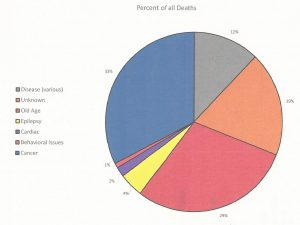 C.A. Sharp & Liz Busquetts
C.A. Sharp & Liz Busquetts
first published in the Aussie Times July-August 2018
Thank you to the hundreds of people who took the time to fill out our survey; we realize that for some of you this may have rekindled sad or even painful memories. We appreciate your willingness to participate.
We would also like to thank Bill Dakin for creating our web-mounted version of the survey, Club Français Berger Australien and the Australian Shepherd Klub for assisting with French and German versions of the survey, Kristie Klein and Bill – again – for helping promote the survey, and Karen Wimbush PhD and Juliette Bercovici PhD for reviewing and offering comment on the draft of this report.
The Australian Shepherd Health & Genetics Institute, Inc. (ASHGI) collected longevity-related data incidentally in prior breed health surveys (1,2). However, the only longevity-specific study which included the Australian Shepherd was one conducted in the late 1990s by John B. Armstrong PhD of the University of Ottawa. This effort focused on the correlation between longevity and inbreeding but his research paper was not published due to his untimely death. However, the Australian Shepherd data was preserved by author Sharp, who assisted Dr. Armstrong in the project. This data is now in the possession of ASHGI. Dr. Armstrong’s observation that cancer deaths in the breed appeared to be occurring at a younger age in more recent dogs was the inspiration for ASHGI’s 2007 cancer survey (1).
Given the almost two decades that have passed since Armstrong’s effort, ASHGI decided to conduct a longevity-specific survey to elicit data which could help guide our educational efforts and research support. Since people are more likely to take the time to complete a short survey than one that is long and complex, we decided to keep it simple. We requested only the dog’s name, registration number(s) and registry(ies), names of parents, dates of birth and death, whether euthanized, cause of death, location where the dog lived most of its life (state/province and country), and the respondent’s name and e-mail. The questions were preceded by a confidentiality statement (3).
The survey was limited to dogs which lived at least six months and died on or after January 1, 2000. We limited it to dogs that died at 6 months and older for three reasons:
- We did not want to include neonatal and early puppy deaths as the cause is generally accidental, due to a management issue, or undetermined.
- People tend not to report deaths in very young dogs.
- Significant and potentially lethal heritable diseases in the breed commonly arise in adult dogs, occasionally in older juveniles, and infrequently in young puppies.
The Survey
The survey form was mounted on SurveyMonkey, a simple-to-use and economical web-based survey hosting site. Before and during the survey we promoted it via our Facebook page, our e-newsletter, ASHGI Lifeline, and through ads in the Aussie Times and Australian Shepherd Journal. The survey period was opened on June 1, 2017 and closed on October 7, 2017. During that time 455 responses were received, of which 443 actually completed the survey.
During the data-collection period a follower of ASHGI’s Facebook page pointed out that SurveyMonkey is a supporter of a major animal rights organization with a stated opposition to the existence and continuation of purebred dogs. SurveyMonkey was also directing targeted ads for that organization to participants at completion of the survey (as author Sharp discovered upon entering one of her own dogs).
Reaction on our Facebook page was highly negative. Some advocated boycott of the survey, which may have limited survey responses. To offset that possibility, we quickly put up a statement that we had been unaware of the relationship between SurveyMonkey and the animal rights group, explaining that we were unhappy with the situation but could not change platforms as the survey was in progress. We also pledged not to use this platform in the future and offered a paper or pdf version of the survey to any who requested it.
While the survey was in progress the Club Français Berger Australien (the French national breed club) and the Australian Shepherd Klub (an Austrian breed health group) made the survey available in French and German respectively. Between them, these other-language efforts gathered more than 80 additional responses.
The Data
We augmented data gathered during the present survey with data on dogs for whom we had dates of birth and death from our prior general health and cancer surveys (1,2), data available from kennel club and national breed club on-line databases, and ASHGI’s International Directory for Australian Shepherd Health (IDASH) database. We merged these datasets, eliminating duplicates, to produce a more robust set of 1502 dogs.
Analysis (4)
The Australian Shepherd is a populous and popular breed. Estimates of world population are difficult to make given the multiple countries and registries involved, but most dogs are in North America and Europe. In 2017 the Breed ranked 17th in American Kennel Club (AKC) registrations of the 190 breeds in that registry at the time, which is higher than the rank of 20 in 2013 (5) and a huge increase from 2002 when the breed ranked 35th (6). During the same time the breed population has also increased in Europe, the second major population center. The AKC no longer releases total registration numbers for breeds, but based on the AKC numbers in our database issued for the year 2013 there were over 35,000 litters registered in that year (the first six numerical digits represent a litter). A conservative estimate of litter size extrapolates to over 100,000 AKC puppies produced in 2013. World-wide population may exceed a million dogs. It is impossible with a survey of this type to get proportional sampling from all locales but both the United States (US) and Europe, the two major population centers, are well-represented in the dataset as will be discussed below.
Calculations were performed on the full dataset for average, median (the point at which half the data are greater and half lower) and standard deviation (SD – a measure of the breadth of distribution found among the individual data). (Figure 1)
We found a median of 11.61 years and an average of 10.74. When all accidental causes of death were eliminated the median was 11.71 and the average 10.90 – slightly longer and possibly reflecting the greater likelihood for young dogs to get themselves into potentially lethal situations. The lowest SD was found in dogs reported to die of old age; a low SD indicates that the most the data are close to the average. The more widely distributed the data are, the higher the SD. The highest we found was for other (non-natural) causes which, due to their relatively random nature, may occur at any age.
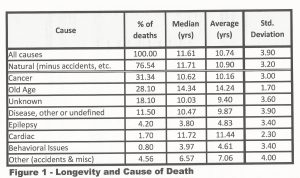 We also made average and median calculations on various subsets of data and looked for changes over time for some portions of the data. Those findings will be discussed below.
We also made average and median calculations on various subsets of data and looked for changes over time for some portions of the data. Those findings will be discussed below.
Euthanasia
The survey asked whether or not a dog had been euthanized but only 43% of the full dataset included that information. Of those that did, 77% were euthanized. The most common reason was cancer (44%) followed by old age (24%). For the purposes of the survey old age was defined as dogs who died at 12 years or older for whom we had no specific cause of death.
Age at euthanasia (Figure 2) varied widely. Not surprisingly, approximately 50% of the euthanized dogs were twelve years or older – a final kindness for a suffering old friend.
The youngest, under five years of age, were lost to accidents and a variety of acquired diseases. However, 36.7% of this group were euthanized because of epilepsy, an indication of the serious impact this inherited disease can have on younger dogs.
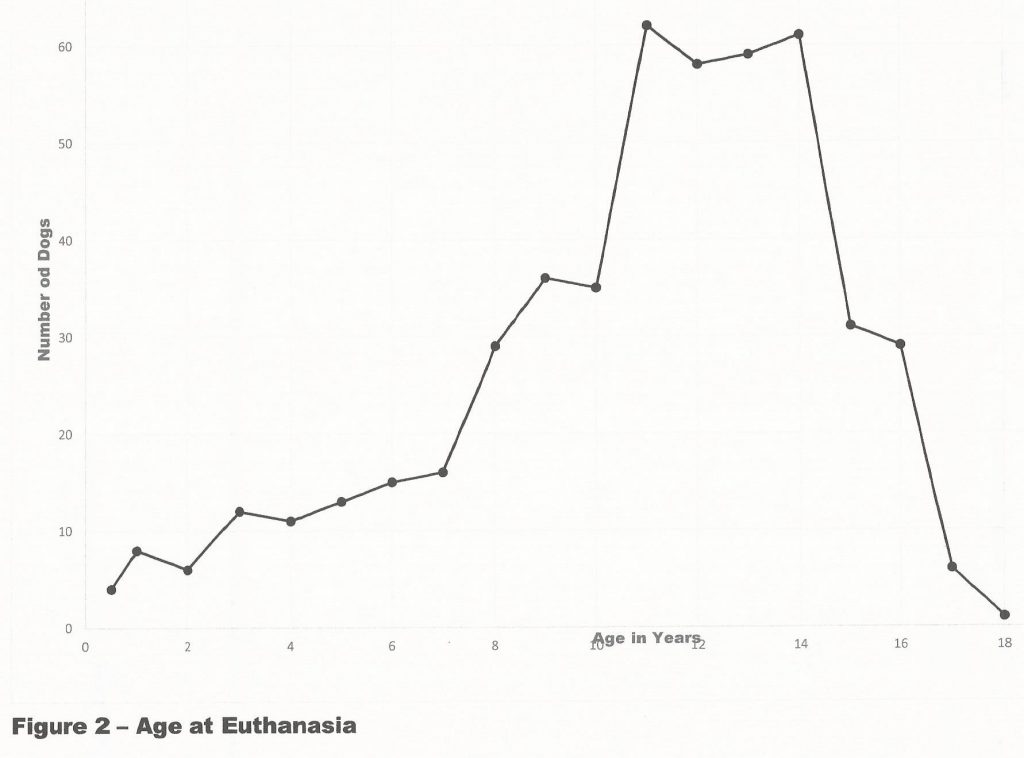 Dogs over five and under ten years should be enjoying the prime of their life but some are not so fortunate and suffer serious accidents as well as diseases. Some of the latter are inherited or carry inherited risk: Epilepsy (6%), lymphoma (14%) and hemangiosarcoma (26%). Jointly, these three diseases, all common in the breed, made up 54% of the reported euthanasia in this age bracket and will be referred to as “The Big Three” heritable diseases.
Dogs over five and under ten years should be enjoying the prime of their life but some are not so fortunate and suffer serious accidents as well as diseases. Some of the latter are inherited or carry inherited risk: Epilepsy (6%), lymphoma (14%) and hemangiosarcoma (26%). Jointly, these three diseases, all common in the breed, made up 54% of the reported euthanasia in this age bracket and will be referred to as “The Big Three” heritable diseases.
Gender bias
We made one inadvertent but glaring omission in the survey form: Gender. Fortunately, we were able to obtain gender information on 1421 (95%) of the dogs in the full dataset from other sources, mostly our own pedigree database but also various heath and studbook registries, and by contacting the owners. We were able to determine altering status, though not age of altering, on 119 of those dogs. We do not know what portion of the remainder may have been altered. More precise altering age data would likely have produced a better indication of whether and how the procedure might impact longevity.
Calculation of median and average longevity for dogs with natural causes of death showed that females appear to live about a half year longer than males (see Figure 3). The difference is small, but it may reflect a tendency for females to be slightly longer lived. We also looked at dogs of unknown gender, which had considerably lower median and average longevity but this is almost certainly related to their birthdates – 51% of these dogs were born after 2000 and many born in this time period are still living. There was no significant difference between altered and intact dogs with one exception, a 0.7 year shorter lifespan for altered males. The altered male number may be an artifact of a relatively small subset of the data, however it reflects similar findings in a longitudinal study of Golden Retrievers. (7)
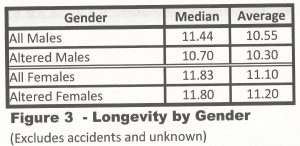 There was no great difference between various natural causes of death (cancers, epilepsy, heart disease, other diseases and old age) in relationship to gender and altering status. Risk for cancers other than hemangiosarcoma (HSA) and lymphoma appeared to be lower for intact males than for any of the other groups. On the other hand, males may be at a higher risk for kidney disease and intact males for epilepsy, though the low numbers for altered males in this category may also reflect a reluctance on the part of owners to subject these dogs to an elective surgery.
There was no great difference between various natural causes of death (cancers, epilepsy, heart disease, other diseases and old age) in relationship to gender and altering status. Risk for cancers other than hemangiosarcoma (HSA) and lymphoma appeared to be lower for intact males than for any of the other groups. On the other hand, males may be at a higher risk for kidney disease and intact males for epilepsy, though the low numbers for altered males in this category may also reflect a reluctance on the part of owners to subject these dogs to an elective surgery.
We were fortunate to have a number of parent/offspring cohorts in the dataset so we reviewed data for both sires and dams. We included in this group dogs which had at least two offspring in the data, identifying 74 sires and 47 dams. We compared parent/offspring longevity and causes of death. Only one thing stood out: HSA. All of the sires and 57% of the dams who died of HSA had at least one offspring that also died of HSA.
Changes Over Time
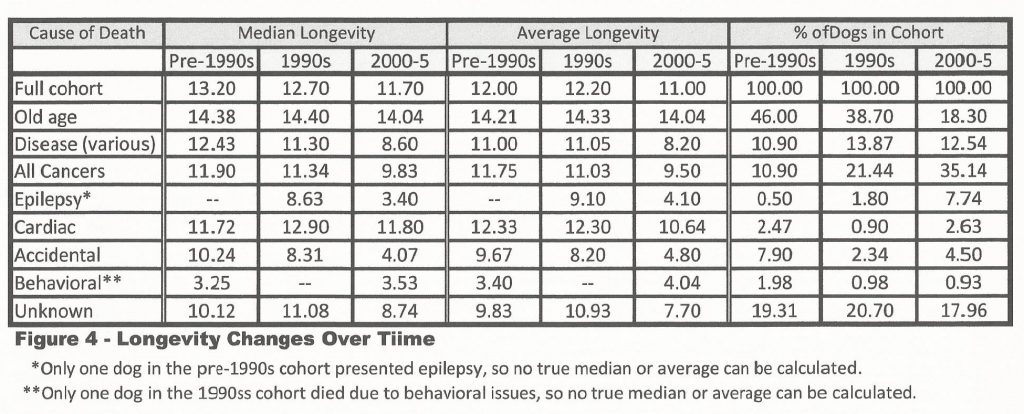 The earliest birthdate was 6/20/69 and the latest was 9/23/16. We divided the full dataset into three groups based on date of birth: pre-1990 (239 dogs), 1990-1999 (614), and 2000-2005 (382). Dogs born after 2005 were eliminated from the median and average calculations (Figure 4) to prevent bias of the data toward younger dogs that would arise from including dogs born during a period where many are still living. These findings indicate a relatively steady decline in over-all longevity. There is an 8.3% decline in average longevity from the pre-1990s group to the 2000-2005 group. An 11.4% decline in median longevity indicates that more dogs are dying at a younger age.
The earliest birthdate was 6/20/69 and the latest was 9/23/16. We divided the full dataset into three groups based on date of birth: pre-1990 (239 dogs), 1990-1999 (614), and 2000-2005 (382). Dogs born after 2005 were eliminated from the median and average calculations (Figure 4) to prevent bias of the data toward younger dogs that would arise from including dogs born during a period where many are still living. These findings indicate a relatively steady decline in over-all longevity. There is an 8.3% decline in average longevity from the pre-1990s group to the 2000-2005 group. An 11.4% decline in median longevity indicates that more dogs are dying at a younger age.
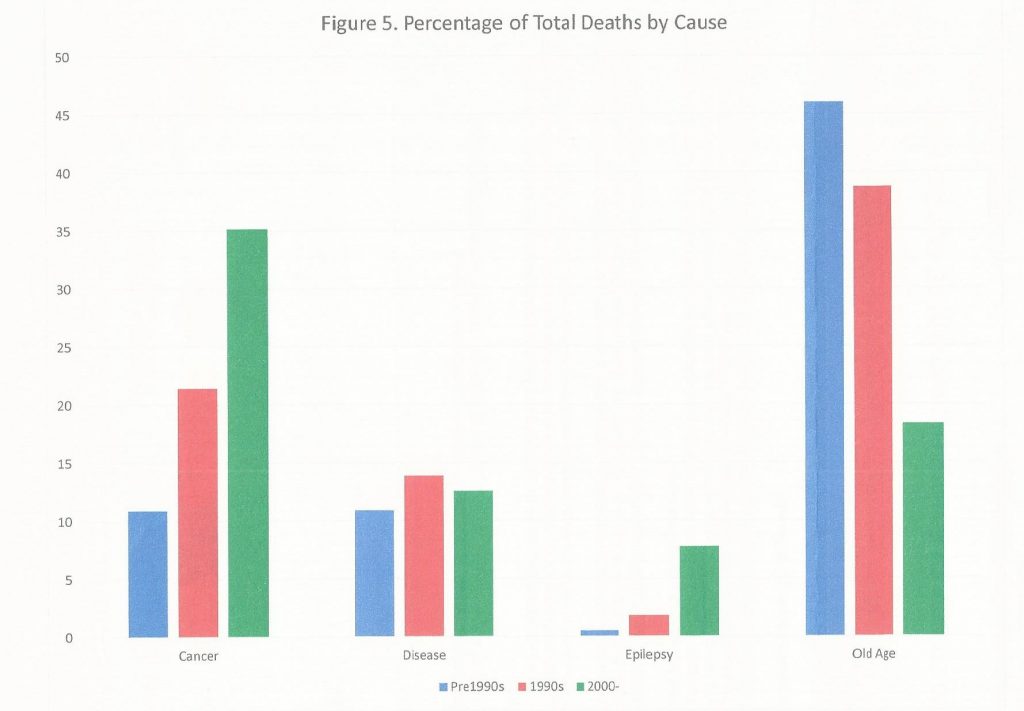 There were also trends within causes of death. (Figure 5) The marked increase in percentage of cancer deaths and, to a lesser degree, epilepsy as well as the concurrent decline in dogs reported to have died of old age is disconcerting when you consider the Big Three. Roughly half the reported cancers were HSA or lymphoma. However, the increasing recognition of cancer as a general canine health concern over the same period may have some influence on the level of more recent reports. On the brighter side, declines in percentages of dogs lost to accidents and behavioral issues likely reflects better standards of care and an increased willingness by owners to seek help for serious health or behavioral issues.
There were also trends within causes of death. (Figure 5) The marked increase in percentage of cancer deaths and, to a lesser degree, epilepsy as well as the concurrent decline in dogs reported to have died of old age is disconcerting when you consider the Big Three. Roughly half the reported cancers were HSA or lymphoma. However, the increasing recognition of cancer as a general canine health concern over the same period may have some influence on the level of more recent reports. On the brighter side, declines in percentages of dogs lost to accidents and behavioral issues likely reflects better standards of care and an increased willingness by owners to seek help for serious health or behavioral issues.
A Matter of Geography
There were no geographic limitations on who could submit dogs. The bulk of the breed lives in North America (74% of submissions) with a second significant population in Europe (22% of submissions). The European data is likely below a proportional level due to the survey having been available only in three languages. Aussies can be found on every continent except Antarctica. Not surprisingly, most submissions were from the US, where the breed was developed. Based on the survey, 75% were in the US followed by France (7%), Netherlands (6%), Germany (4%), Canada (3%), and Finland (2%). Each of the other twelve countries from which we have data were each less than 2%.
We wanted to determine whether there were any regional differences in longevity so we compared North America (US and Canada) to Europe (Austria, Belgium, Czech Republic, Denmark, Estonia, Finland, France, Germany, Netherlands, Norway, Poland, Slovenia, Sweden, Switzerland, and the United Kingdom). (Figure 6)
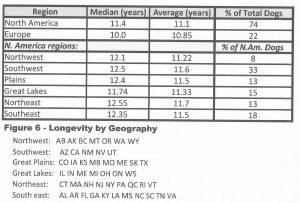 The marked difference between North America and Europe for median and average longevity is interesting but the cause is not clear. Standards of care for dogs in Europe are generally good and the more prosperous European nations tend to have good environmental laws which could reduce environmental effects on canine health. The difference may reflect a longer tradition of open health reporting in Europe. Some of the European data came from national breed club and kennel club health registries whose North American counterparts typically do not maintain this type of publicly accessible database. This established European practice may also be reflected in the data submitted by European individual respondents who may be more comfortable in sharing data on deaths of younger dogs than North Americans, for whom the open health movement is more recent. When we looked at causes of death, as categorized in Figure 1, we found no significant difference between the two, possibly due to frequent European imports of breeding stock from North America.
The marked difference between North America and Europe for median and average longevity is interesting but the cause is not clear. Standards of care for dogs in Europe are generally good and the more prosperous European nations tend to have good environmental laws which could reduce environmental effects on canine health. The difference may reflect a longer tradition of open health reporting in Europe. Some of the European data came from national breed club and kennel club health registries whose North American counterparts typically do not maintain this type of publicly accessible database. This established European practice may also be reflected in the data submitted by European individual respondents who may be more comfortable in sharing data on deaths of younger dogs than North Americans, for whom the open health movement is more recent. When we looked at causes of death, as categorized in Figure 1, we found no significant difference between the two, possibly due to frequent European imports of breeding stock from North America.
Since the majority of Aussies live in North America we wanted to take a closer look at that continent and divided the US and Canada into regions that share more-or-less similar physical geography. We did not subdivide states or provinces because specific addresses were not available. The postal initials for each state and province included in a region are listed below Figure 6. Those which are omitted had no data attributed to them.
Average longevity is fairly similar across North American regions (Figure 7) but the median longevity for the Great Lakes region is markedly lower than that of the others, indicating that more dogs are dying younger. The average is also on the lower end of the range for the regions. This region had only 12% of the dogs for whom we had North American location data so it may be an artifact of a smaller dataset. In all regions the median is higher than the average, indicating that most dogs are living beyond that region’s average. However, in all regions the average is below 12 years which points to a considerable number of deaths in dogs well before age of 10.
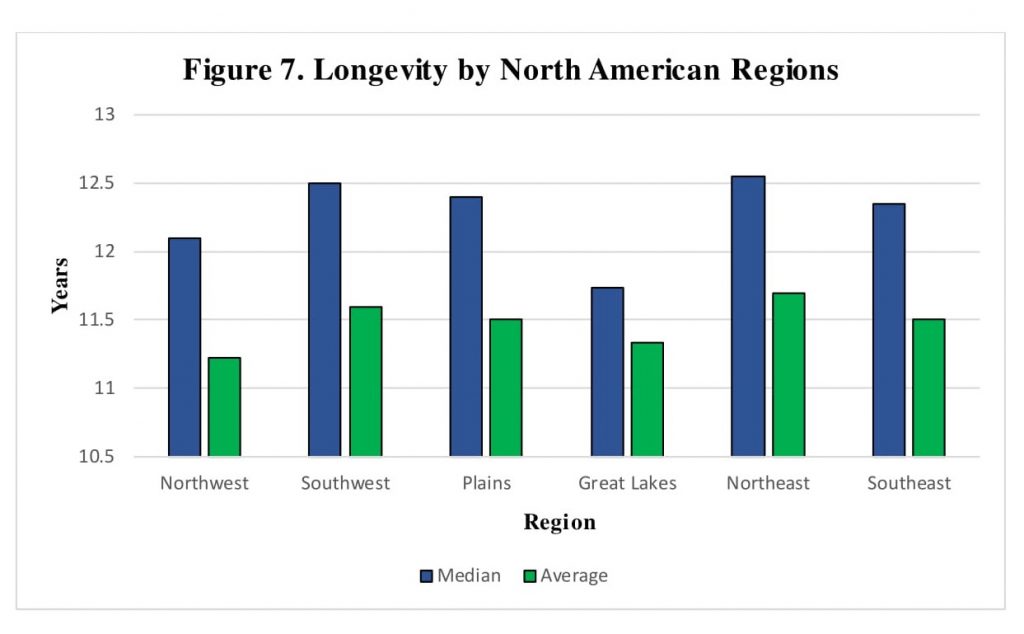
How They Died
Respondents were asked to provide their dogs’ cause of death. Most of the other-source data also included this information. Where it did not, if a dog met our criteria for “Old Age” death (12 and older) it was classified as such. All others without specific cause, whether from the survey form or other sources, were classified as “Unknown.” Cancer, the most common cause of death, will be discussed in greater detail below. This group of diseases is a major killer of dogs as a species, just as it is for humans. Epilepsy was the only non-cancer cause of death for a significant number of dogs (4%) either due the disease or euthanasia because of it.
The items of greatest concern are the cause-of-death categories with lower median and/or average, indicating shorter lifespan, and/or higher percentages and therefore affecting greater numbers of dogs. Causes with the shortest longevity were epilepsy, followed by behavioral issues, then “Other” which was mostly accidents. That the young are more prone to lethal accidents is not surprising. The behavior-related deaths, fortunately, represent less than 1% of Aussies in the full dataset.
Accidents are never totally avoidable, especially in a high-energy, curious breed. Various types of traumatic death were reported but more than half arose from two causes: 34.5% were vehicle impact and 24.1% were fatal interactions with other animals, mostly dog fights.
The analysis showed that 28.1% died of old age. The median age for this group was 14.34 years, which means that half of the “old age” dogs died after 14.3 years. The oldest dog reported to the survey was born in 1994 and lived to an astounding 18.75 years. The only other dog that came close was born in 1976 and lived to 18.5.
Epilepsy also caused a significant portion of deaths (roughly one in 25). The impact on lifespan highlights the need to prioritize reduction of the frequency of this common and potentially lethal disease.
Heart problems were reported in 2% of the dogs but most respondents did not give specific diagnoses. Congestive heart failure was noted in 26% of these dogs. Cardiac issues in Aussies are almost always found in older dogs, the youngest to die was 3 years old but the majority were over 10.
Time Goes By
We wanted to take a more detailed look at the different natural causes of death to see if there were any trends over time. (Figure 8) The breed population has grown considerably from its early years, so we used the percentage of dogs per period to avoid a false appearance of increased disease frequency due a larger population. All dogs prior to 1989 were combined because their representation in the data was roughly equivalent to the other time periods in the graph and the percentages of the listed causes of death in this group were low.
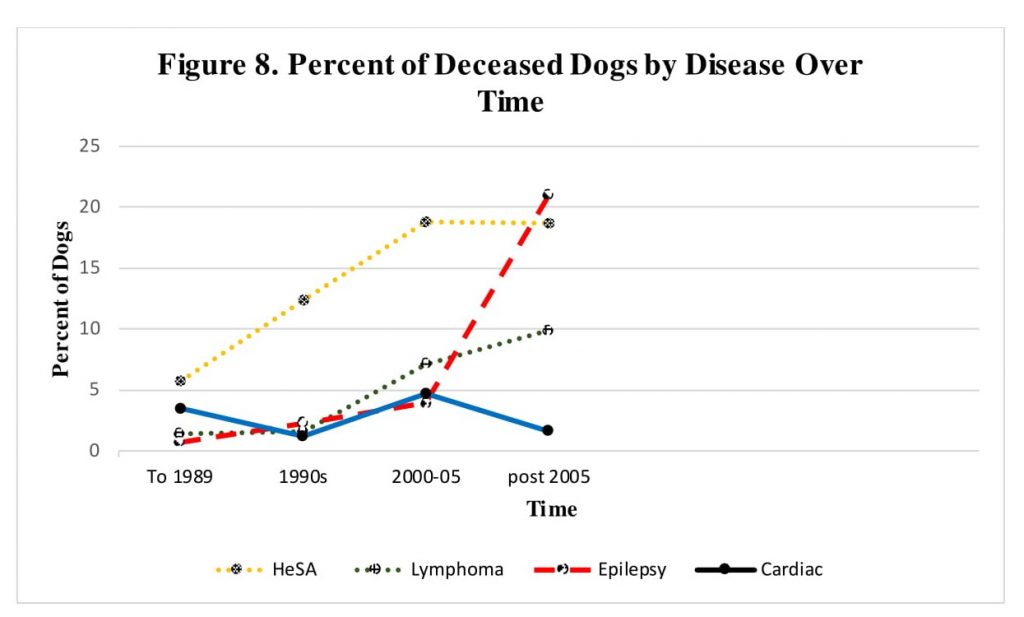 Cardiac diseases, which are mostly an old age issue in Aussies, were included as a control and remained at roughly the same level across time with a drop in the most recent period, most likely because dogs that will die of it haven’t done so yet. Lymphoma and epilepsy are both diseases that arise in and are likely to kill dogs under 10; both show a significant increase from the pre-1989 period to the present. Lymphoma’s rise has been relatively steady. Epilepsy deaths also rose steadily through the 1990s but were still under 5%. Since then, they have grown significantly though probably not as much as indicated here given that things which kill older dogs are not fully represented in the final group.
Cardiac diseases, which are mostly an old age issue in Aussies, were included as a control and remained at roughly the same level across time with a drop in the most recent period, most likely because dogs that will die of it haven’t done so yet. Lymphoma and epilepsy are both diseases that arise in and are likely to kill dogs under 10; both show a significant increase from the pre-1989 period to the present. Lymphoma’s rise has been relatively steady. Epilepsy deaths also rose steadily through the 1990s but were still under 5%. Since then, they have grown significantly though probably not as much as indicated here given that things which kill older dogs are not fully represented in the final group.
The most disturbing increase is that of HSA. This cancer has increased significantly, tripling in frequency through the periods prior to 2007 when it was first recognized as a significant health issue. The leveling-off from 2005 to the present reflects the lack of older dogs in this cohort; that level line between 2005 and the present will very likely go up even beyond its present sobering height when the fates of dogs now living are known.
Cancer and the death of Aussies
Cancer is clearly the most frequent cause of death in the breed, accounting for almost one third of the dogs in this survey. Cancer isn’t one disease, it is many. The great majority of cancers are acquired – caused by environmental and other non-hereditary factors. Only HSA and lymphoma happen at high frequency and both have previously been identified as carrying inherited risk in this breed. (1)
 We determined the median longevity for HSA, lymphoma, and all other cancers combined. (Figure 9) We also calculated the percentage of all cancers for each of the three time periods indicated. Finally we calculated the percentage of change between the early and late periods.
We determined the median longevity for HSA, lymphoma, and all other cancers combined. (Figure 9) We also calculated the percentage of all cancers for each of the three time periods indicated. Finally we calculated the percentage of change between the early and late periods.
Median longevity is relatively steady for lymphoma and the other cancers but has dropped precipitously for HSA. To some degree that is a reflection of the fact it does not include dogs born in this period that haven’t yet died of the disease. Even so, some degree of decrease in median longevity is probable, which means more of the HSA dogs are dying at earlier ages.
The changes in the percentages of cancer types from the early to the recent period are also a matter of concern. The percentage of the other cancers has dropped while both HSA and lymphoma have increased. Their relative increases are likely to decrease for lymphoma and increase for HSA once the ultimate fate of dogs born in the current period is known. The 8.1% difference between the early and middle time periods for HSA is probably more indicative though likely on the low side.
COI and Longevity
We wanted to determine whether coefficient of inbreeding (COI) showed any correlation to longevity. COI determines level of inbreeding by calculating how likely the individual is to have genes that are identical by descent (inherited from a single ancestor down both sides of the pedigree). The more ancestors a dog has that are on both sides of its pedigree and the greater the number of times those ancestors appear, the higher the COI will be. For a general reference, the average COI for all dogs in the full ASHGI pedigree database is about 12.5%, a level fairly typical for purebred dog populations.
We identified 1377 dogs in the longevity survey dataset (91.7%) which had known pedigree for COI calculation. We calculated median and average COI for these dogs as a group then did a breakdown by age and for the Big Three. For the most part the results are unremarkable. There was no significant difference between age groups or the diseases for either average or median COI. This indicates that increased levels of inbreeding are not associated with deaths due to these three ailments and may not be significant in overall longevity. However, a larger data set or, probably more pertinent, one drawn from a more-or-less current population rather than one that ranges over half a century as this one did, might be more informative.
The Take-Away
This survey has identified several important facts that Australian Shepherd clubs and health foundations may wish to consider when setting education and research funding priorities and which breeders should heed while making mating decisions:
- There has been a significant (11.4%) decline in overall longevity since 1990.
- The Big Three heritable diseases – HSA, lymphoma and epilepsy – accounted for more than half the euthanasia in the 5-10 year old group with HSA responsible for half of them.
- Percentage of deaths from the Big Three have risen significantly in recent years with HSA deaths nearly tripling since 1990.
- HSA and lymphoma account for well over half of all cancer deaths in the breed with HSA twice a frequent as lymphoma.
- Breeding dogs which develop HSA are extremely likely to have offspring with HSA.
- HSA is killing more dogs under 10 years of age now than in the past.
- Epilepsy is the most significant reason for euthanasia in young dogs (under 5) other than accidents.
- Most frequent causes of accidental deaths are being hit by a vehicle and fatal interactions with other animals, especially other dogs.
What YOU can do to help improve longevity
While some of what we discovered thorough this survey is distressing to anyone who loves this breed, there are steps we can take that can improve longevity if we are willing to put in the time and effort.
Accidents are potentially preventable. Clubs and breeders could do more to educate pet owners and puppy buyers about preventing death-by-vehicle. Breeders need to recognize the risk of death from dog-on-dog aggression and breed away from this dangerous behavior which the ASCA standard describes as “intolerable” and the AKC standard says should be “severely penalized.”
Breeders need to pay more attention to the Big Three. Certainly no one is intentionally breeding dogs to have these diseases but mate selection practices over the past two decades have resulted in a marked increase of deaths from all three. There are no DNA tests for these diseases; given that they all have complex inheritance, we aren’t likely to have such tests in the foreseeable future. But there are things breeders can do.
Virtually everyone would agree that, once diagnosed, these dogs should not be bred. By extension, stored semen from a dog diagnosed with any of the Big Three should be discarded. Healthy relatives who are to be bred should paired only with mates who do not have a recent family history of the disease. However, in the case of epilepsy ASHGI has long advised that first-step relatives (parents, offspring and siblings) of affected dog be removed from breeding, a stand made all the more pertinent in view of the steady increase in percentage of deaths due to epilepsy. In the case of HSA, having an affected parent puts a dog at high risk but the typically late onset makes it impossible to wait a few years before breeding not to mention identify which dogs will have parents that develop the disease. If a healthy dog has even one case of this disease within two generations it should be bred only to mates who have at least three generations clear of HSA and without recent collateral relatives who had it.
Finally – and most important – talk to one another. Denial and silence never improve a bad situation and victim-blaming should not be tolerated. If nobody discusses these diseases, shares pedigree information, or submits data on affected dogs to open-source health resources, like ASHGI’s IDASH Open Health Database, the statistics from some future longevity survey could be very dire indeed.
Notes:
- Sharp, CA; L Busquets “2007 ASHGI Cancer Survey” Aussie Times Nov-Dec 2007
- Sharp, CA “2010 ASHGI Breed Health Survey” Aussie Times Sep-Oct 2011
- CONFIDENTIALITY STATEMENT: Information submitted to this survey is confidential, with one exception: Date of death will be included in ASHGI’s pedigree database which is a public resource. Cause of death and all other data will remain confidential. ASHGI will not issue reports containing specific information about any individual dog; published survey reports will be statistical in nature and based on summary data. However, by participating in this survey you do agree to share this data with legitimate researchers who may request longevity data or a copy of our pedigree database.
- Average (mean), median, and standard deviation calculations for this report were performed with Microsoft Excel. Coefficients of Inbreeding (COI) were calculated to ten generations with Breedmate PedX.
- American kennel Club, “Most Popular Breeds – Full Ranking” http://www.akc.org/expert-advice/news/most-popular-dog-breeds-full-ranking-list/ March 28, 2018
- American Kennel Club, “Most Popular Dog Breeds Based on AKC Registrations 2002, 2007, 2011, 2012” https://nilesanimalhospital.com/news/most-popular-dog-breeds-based-on-akc-registrations-2002-2007-2011-2012/ December 26, 2013
- Torres de la Riva, G; BL Hart, et al, “Neutering Dogs: Effects on Joint Diseases and Cancers in Golden Retrievers”, PLOS/one, Feb. 13, 2013 http://journals.plos.org/plosone/article?id=10.1371/journal.pone.0055937
